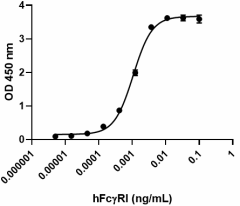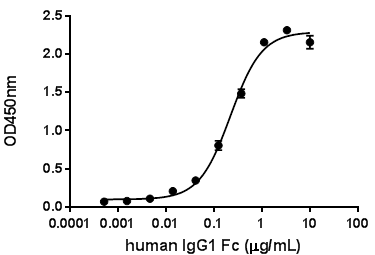- Regulatory Status
- RUO
- Other Names
- FcgammaRIa, Fc-Gamma RI, Fc-Gamma RIA, IgG Fc Receptor I, Fc Gamma Receptor Ia, High Affinity Immunoglobulin Gamma Fc Receptor I, Fc Fragment Of IgG, High Affinity Ia, Receptor (CD64), Fc Fragment Of IgG Receptor Ia, FCGR1A, FcγR1A
- Ave. Rating
- Submit a Review
- Product Citations
- publications

-

When Ultra-LEAF™ purified human IgG1 isotype control recombinant antibody (Cat. No. 403501) is immobilized at 0.5 μg/mL, human FcγRI binds in a dose-dependent manner. The EC50 range for this effect is 0.5 - 2.0 ng/mL. HRP anti-His Tag antibody (Cat. No. 652503) was used to detect the binding. -

Stability testing for human FcγRI. Recombinant human FcγRI was aliquoted in PBS at 0.2 mg/mL. One aliquot was frozen and thawed four times (4x Freeze/Thaw), and compared to a control kept at 4⁰C (Control). The samples were tested in a binding assay with human IgG1.
Select size of product is eligible for a 40% discount! Promotion valid until December 31, 2024. Exclusions apply. To view full promotion terms and conditions or to contact your local BioLegend representative to receive a quote, visit our webpage.
FcγRI, also known as CD64 and FcR I, is a type I transmembrane protein, belonging to the immunoglobulin superfamily. FcγRI is an Fc receptor that binds to monomeric IgG with high affinity. Human FcγRI binds to human IgG1, IgG3 and IgG4 with higher affinity, but no affinity for IgG2. However, murine FcγRI only binds to mouse IgG2a with high affinity, but it binds to mouse IgG2b and IgG3 with low affinity and no affinity for mouse IgG1. Upon binding to IgG, FcγRI associates with signal-transducing FcR common γ chain, and in turns conducts downstream signaling. Though the Fc γ chain is dispensable to FcγRI ligand-binding capacity, the surface expression of FcγRI and signaling are impaired in Fc γ chain-deficient cells. FcγRI is exclusively expressed on myeloid cells, including monocytes/macrophages, dendritic cells, and inducible on neutrophils and mast cells. The expression can be upregulated by IFN-γ, IL-10 and G-CSF stimulation. Several studies demonstrated that FcγRI plays a role in antigen capture, IgG-induced cellular phagocytosis and antibody-dependent cellular cytotoxicity (ADCC). In FcγRI-deficient mouse macrophages, the IgG2a-induced phagocytosis and antibody-mediated killing were impaired. In addition, acute and chronic inflammatory responses and immune complex-dependent antigen presentation to primed T cells were disturbed in FcγRI-deficient mice.
Product DetailsProduct Details
- Source
- Human FcγRI, amino acid Gln16-Pro288 (Accession # P12314), with 6His tag was expressed in CHO cells.
- Molecular Mass
- The 282 amino acid recombinant protein has a predicted molecular mass of approximately 31.6 kD. The DTT-reduced protein and the non-reduced proteins migrate at approximately 50 kD by SDS-PAGE. The predicted N-terminal amino acid is Gln.
- Purity
- >95%, as determined by Coomassie stained SDS-PAGE.
- Formulation
- 0.22 µm filtered protein solution is in PBS, pH 7.2
- Endotoxin Level
- Less than 0.1 EU per µg protein as determined by the LAL method.
- Concentration
- 10 and 25 µg sizes are bottled at 200 µg/mL. 100 µg size and larger sizes are lot-specific and bottled at the concentration indicated on the vial. To obtain lot-specific concentration and expiration, please enter the lot number in our Certificate of Analysis online tool.
- Storage & Handling
- Unopened vial can be stored between 2°C and 8°C for up to 2 weeks, at -20°C for up to six months, or at -70°C or colder until the expiration date. For maximum results, quick spin vial prior to opening. The protein can be aliquoted and stored at -20°C or colder. Stock solutions can also be prepared at 50 - 100 µg/mL in appropriate sterile buffer, carrier protein such as 0.2 - 1% BSA or HSA can be added when preparing the stock solution. Aliquots can be stored between 2°C and 8°C for up to one week and stored at -20°C or colder for up to 3 months. Avoid repeated freeze/thaw cycles.
- Activity
- When Ultra-LEAF™ purified human IgG1 isotype control recombinant antibody (Cat. No. 403501) is immobilized at 0.5 μg/mL, human FcγRI binds in a dose-dependent manner. The EC50 range for this effect is 0.5 - 2.0 ng/mL. HRP anti-His Tag antibody (Cat. No. 652503) was used to detect the binding.
- Application
-
Bioassay
- Application Notes
-
BioLegend carrier-free recombinant proteins provided in liquid format are shipped on blue ice. Our comparison testing data indicates that when handled and stored as recommended, the liquid format has equal or better stability and shelf-life compared to commercially available lyophilized proteins after reconstitution. Our liquid proteins are verified in-house to maintain activity after shipping on blue ice and are backed by our 100% satisfaction guarantee. If you have any concerns, contact us at tech@biolegend.com.
- Product Citations
-
Antigen Details
- Structure
- Immunoglobulin family
- Function
- Activation of naïve T cells, induction of cytokine production, cell survival, and expression of anti-apoptotic proteins including Bcl-XL.
- Interaction
- FcγR subunit, src-type kinase Hck and Lyn
- Ligand/Receptor
- IgG
- Bioactivity
- Measured by its ability to bind human IgG1
- Cell Sources
- In human, FcγRI is restricted to monocytes, macrophage, dendritic cells, but inducible on neutrophils and mast cells. In mice, FcγRI is expressed on dendritic cells and on monocytes/macrophages; plasma membrane.
- Cell Type
- Dendritic cells, Macrophages, Mast cells, Neutrophils, T cells
- Biology Area
- Immunology, Innate Immunity
- Molecular Family
- CD Molecules, Fc Receptors, Soluble Receptors
- Antigen References
-
- van Vugt MJ, et al. 1996. Blood. 87:3593.
- Ravetch JV & Kinet JP. 1991. Annu Rev Immunol. 9:457.
- Perussia B, et al. 1983. J Exp Med. 158:1092.
- Repp R, et al. 1991. Blood. 78: 885.
- Wang AV, et al. 1994. J Exp Med. 180:1165.
- Bruhns P. 2012. Blood. 119:5640.
- Ioan-Facsinay A, et al. 2002. Immunity. 16:391.
- Barnes N, et al. 2002. Immunity. 16:379.
- Gene ID
- 2209 View all products for this Gene ID
- UniProt
- View information about FcgammaRI on UniProt.org
Related FAQs
- Why choose BioLegend recombinant proteins?
-
• Each lot of product is quality-tested for bioactivity as indicated on the data sheet.
• Greater than 95% Purity or higher, tested on every lot of product.
• 100% Satisfaction Guarantee for quality performance, stability, and consistency.
• Ready-to-use liquid format saves time and reduces challenges associated with reconstitution.
• Bulk and customization available. Contact us.
• Learn more about our Recombinant Proteins. - How does the activity of your recombinant proteins compare to competitors?
-
We quality control each and every lot of recombinant protein. Not only do we check its bioactivity, but we also compare it against other commercially available recombinant proteins. We make sure each recombinant protein’s activity is at least as good as or better than the competition’s. In order to provide you with the best possible product, we ensure that our testing process is rigorous and thorough. If you’re curious and eager to make the switch to BioLegend recombinants, contact your sales representative today!
- What is the specific activity or ED50 of my recombinant protein?
-
The specific activity range of the protein is indicated on the product datasheets. Because the exact activity values on a per unit basis can largely fluctuate depending on a number of factors, including the nature of the assay, cell density, age of cells/passage number, culture media used, and end user technique, the specific activity is best defined as a range and we guarantee the specific activity of all our lots will be within the range indicated on the datasheet. Please note this only applies to recombinants labeled for use in bioassays. ELISA standard recombinant proteins are not recommended for bioassay usage as they are not tested for these applications.
- Have your recombinants been tested for stability?
-
Our testing shows that the recombinant proteins are able to withstand room temperature for a week without losing activity. In addition the recombinant proteins were also found to withstand four cycles of freeze and thaw without losing activity.
- Does specific activity of a recombinant protein vary between lots?
-
Specific activity will vary for each lot and for the type of experiment that is done to validate it, but all passed lots will have activity within the established ED50 range for the product and we guarantee that our products will have lot-to-lot consistency. Please conduct an experiment-specific validation to find the optimal ED50 for your system.
- How do you convert activity as an ED50 in ng/ml to a specific activity in Units/mg?
-
Use formula Specific activity (Units/mg) = 10^6/ ED50 (ng/mL)
 Login / Register
Login / Register 












Follow Us